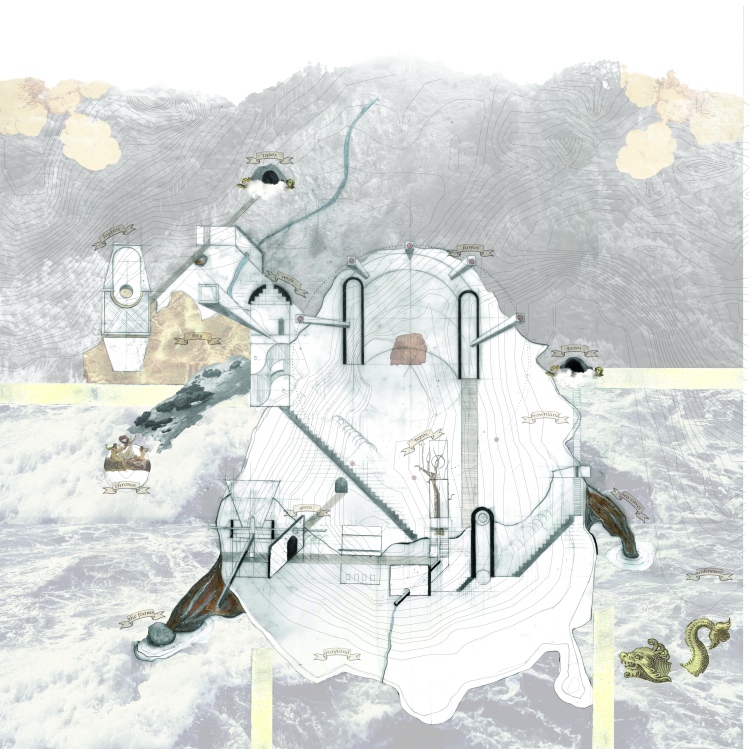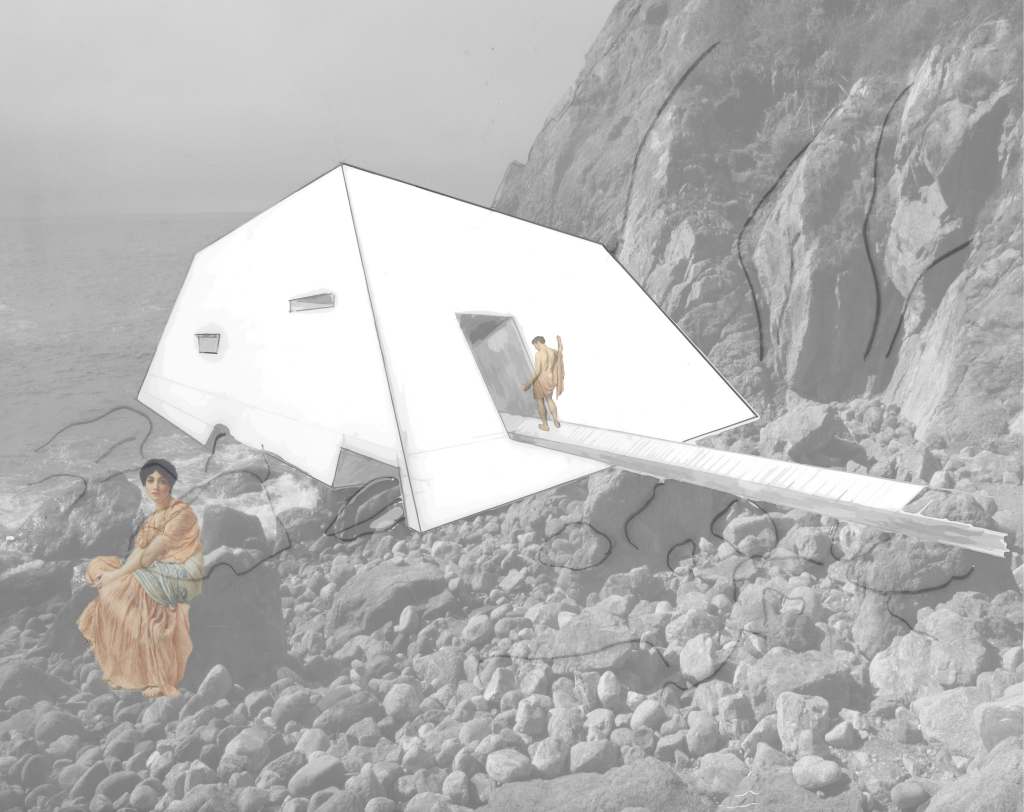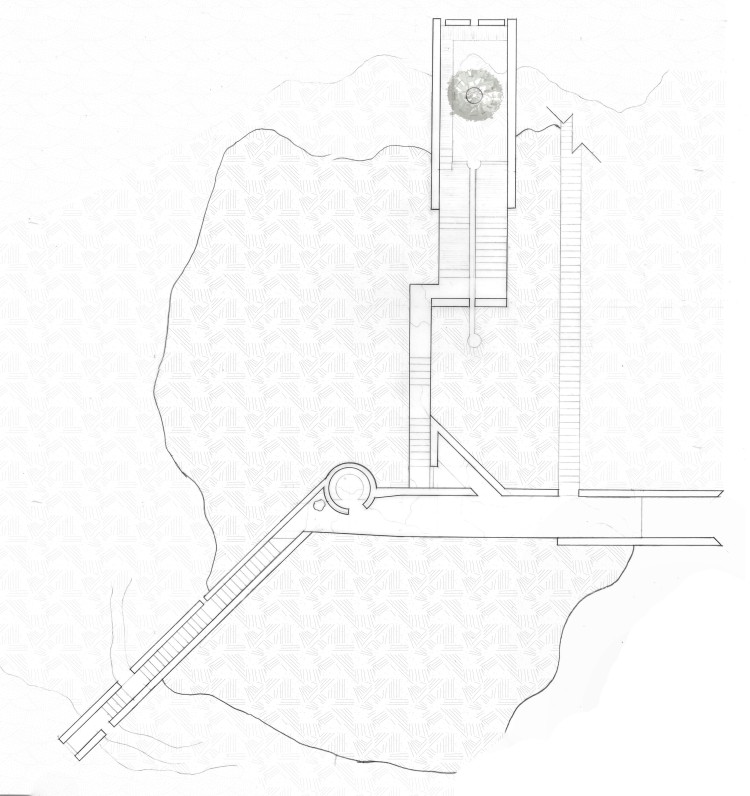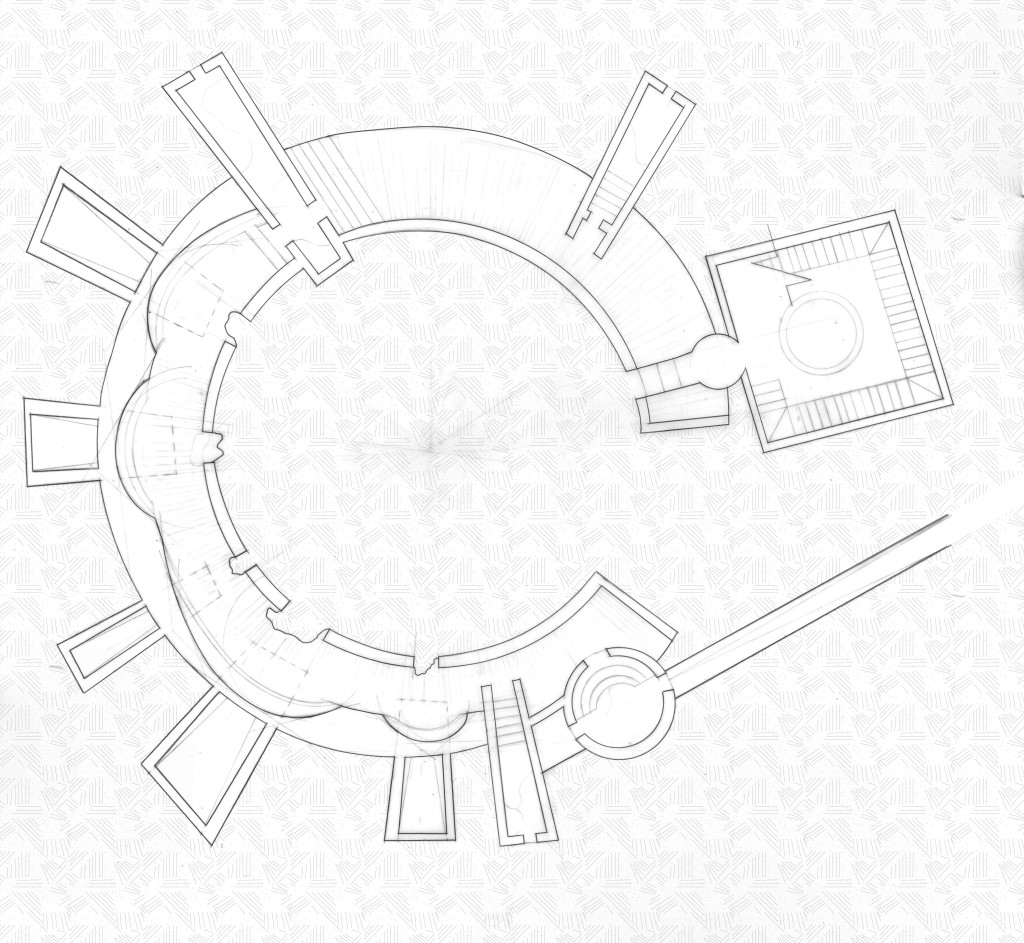
This thesis attempts to frame the natural world as a phenomenological expression of the numinous; in doing so, it seeks to generate a sacred space for praxis, rooted in, derived from, and reflective of Nature. By cutting into the natural world, mirrors, or miradors are generated. These spaces are intended to facilitate a connection, or praxis, with the natural phenomenon they frame, and in doing so, lead to a revelation of the numinous and a sacred experience. How does a non-dogmatic space reveal the numinous ? What are the design principles that must be employed to generate the ‘mysterium tremendum et fascinans’ ? How will landscape design play a critical role in the spatio-spiritual journey of the site ? What is the role of time in sanctifying a site or particular praxis?

This thesis returns to Nature and to the traditional elements of Earth, Water, Light, and Air to generate miradors whose intentions are to reveal the natural phenomena they frame. We can perceive the miradors as centerings of the cosmos, as concentrations of the divine, as reflections of the Self. Other traditions have called them chapels, mihrab, ædicula, shrines, sanctum, or musallah. Each individual is invited to impose their own meanings on the phenomena framed by these miradors, and to have these meanings reflected back
on them. Thus, as architectural theorist Christian Norburg- Schulz states, “Man gathers the experienced meanings to create for himself an imago mundi or microcosmos which concretizes his world. Gathering eventually depends on symbolization, and implies a transposition of meanings to another place, which thereby becomes an existential
center.’’ Pilgrims journeying to this site will be free to experience the numinous as it is revealed to them, as they read the site and experience the miradors, emerging with a
sacred experience deeply rooted in a situational and natural context. In short, the site will reveal itself as a new cosmos to its pilgrims.

The site itself is located in Monterey County, California, along the Pacific Coast Highway, and is part of the Partington Cove Trail near Big Sur. The site is very mountainous and gives way to the Ocean via an elongated threshold of cliffs and boulders. The site was chosen for its unique qualities as it straddles the earth and water. Its terrain is reminiscent of the World Mountain, a concept found in the mythos of myriad cultures. Its promontory also facilitates a stereotomic approach, a temenos, or cut space, that can be reminiscent of another ubiquitous concept, that of the Womb Cavern. Both the World Mountain and Womb Cavern imply burrowing into the earth and reaching to the sky. Mimi Lobell, architect and feminist archaeologist, points to the prevalence of sacred springs in Neolithic cultures, where the earth represented the unconscious prenatal state necessary to enter into communion with the earth goddess as mother, their passageways symbolizing the birth canal. To Neolithic cultures, the goddess was the earth, and thus there was no need for temples: “The esoteric womb is the inner numinous structure from which we give birth to our Selves.” Indeed, it is from this archetype that developed the Hindu garbhagriha, the Buddhist anda, and the Judeo-Christian Holy of Holies. In later cultures, a shift from earth to sky deities turned attention to the sacred mountain archetype, which represented a rising out of primordial chaos and is manifested in the pyramids, stupas, Hindu temples, and Gothic spires. The site’s connection to water is also vital, as water is a sacred element in nearly every culture.



Upon visiting the site, I set out to identify moments that lent themselves to the framing of Nature with the intention of generating three related miradors. As can be seen in the ballad describing the site, these moments revealed themselves as:
The single solitary tree growing out of the rockface;
The bay with boulders and crashing waves;
The interior of the promontory itself: untouched, unscalable, mysterious.
I chose to use each of these moments as a way of framing the traditional elements of Earth (Topos), Light (Lumos), and Water (Hydros), and designed three miradors, or windows onto Nature. Three smaller miradors dedicated to Air (Aeros) would serve as moments of pause. I established the following rules:
The earth must be dependent on the topography as it exists;
The light must be buried in dark to be revealed;
The water must be isolated to be heard and felt;
The wind must be gathered to be seen and smelt;
The human must travel to be made present.



Leaving behind however you got here
on the dusty shoulder of a winding road,
Begin the descent
into a landscape of forest light
and ocean sounds,
a path worn down,
an ancient tunnel, glimpses
of not-quite-natural extrusions soon
to be reclaimed by the Earth.
The path splits, make
a choice – there will be many;
Heading into the Earth, smell
the dampness clinging to the
rough-hewn stone, feel
the humming of the tree roots
burrowing around you, unseen
light ahead and a stair leading upward, go
where the roof turns to wood and folds around
you,
only to unfold and reveal a tree more
ancient than these walls.
Silence, save for the bustling of its pines
Brown and gray, save for the green
of its pines
Unmoving, Time passes.
Awaken, and burrow back into the Earth,
a different stair, uneven,
carved, clings
to the rockface, ascend
to where the stone eroded by
water smooths
into the geometry rendered by man, enter
and hear the Air rushing through,
a moment shared with the sounds of the
Ocean.
Again, pass into the Earth,
climb, emerge
on top of the promontory and see
the Ocean below, the mountains above,
the Sun moving across the sky
casting light and shadow into cones
emerging from the dirt.
There’s a gateway; enter,
descend the steps
into the center of the world
to gray light diffusing across you
-– but
it’s not you, only
a reflection of part of you.
Footsteps resounding upward and
round the vault,
curving inward as the space
circumbalates itself, offering
moments of release where Sun
and Earth align
where rock is illuminated, brick reflected,
and others too, yet untouched by the Light
already abandoned by the Sun.
You’re at the beginning again,
but now it’s the end:
The same tunnel, or a different one
the sound of Air, rushing through like a
whistle, pulls
you on into soaring chambers
where Wind dances
across the ceiling and Air flows through the
walls carrying
voices from across the Ocean, leading
you further still out of the Earth and to its
Edge
where it kisses the Ocean, bursts
of white foam lapping
stones and stone-walls
in a field of boulders, stop
to thank the creek winding through
this place, step
onto the wooden plank that leads into cool
darkness,
a room already consumed by water, folding
around until there is only you
and the Ocean
and the wooden floor,
rocking back and forth,
that separates you.
You are alone with the smell of salt
the rocking of waves
the inner hush of your own heartbeat.
When you emerge, Time
will have passed: 10 minutes or 10 years,
and you’ll climb back up the worn path,
back to the dusty shoulder off the winding
road
and maybe the Sun will be setting
and maybe the Moon will be rising.








topos

In Topos, one journeys along the existing trail that is interrupted by a stair leading into the promontory. It carries you upward, and the roof bends in such a way that the final view is obscured before finally being revealed. The view is of a solitary tree that grows out of the cliff face overhanging the ocean. The cantilevered floor gives way to its presence, and its branches pierce the ceiling plane. The tree itself becomes the mirador’s focus, and pilgrims are invited to sit with it or circumambulate it. There is a sense of being in the Earth as the rock face is exposed along the entry sequence before surrendering to the gray wood at the exterior cantilevered moment. The predominant senses are the tactile and visual. One can feel the wood and smell the tree’s pines. A narrow slit in the façade reminds us that we have emerged from the Earth and hover over the Ocean.




“The earth gives life; it enables the human race to come into being.”
– W. Brede Kristensen
lumos

The Light mirador is a circular path that acts as a clock or calendar. Ten moments along this path are calculated based on the position of the Sun on the two solstices every two hours. These moments architecturalize as apertures that pierce the Earth, filtering natural light down ‘cones’ before illuminating a portion of exposed earth or rock. The architecture itself is a barrel vault with chrome-plated Roman bricks that help to reflect and refract the light around the space. As you circulate through the space, you yourself are reflected, and as the light changes through the day, different moments are illuminated. Benches curved into the brick walls offer moments to witness this dancing of light. The use of reflective brick is two fold: it refracts the light and reflects the self, the later of which transforms the space into what Foucault would call a virtual heterotopia where the boundary between real and virtual is blurred and the inhabitant is made present by confronting their own reflection.
However, this idea can also be applied to all the miradors, which really are like mirrors meant to reflect a certain perceived reality back to the perceiver who then evaluates their own position in the world. The entire site becomes a heterotopia, or as Mircea Eliade would say, a cut through homogeneous space. It transforms into a place apart – a sacred space – meant to confront the liminality between human and nature, nature and divine, human and divine.




“The mirror functions as a heterotopia in this respect; it makes this place that I occupy at the moment when I look at
– Michel Foucault
myself in the glass at once absolutely unreal, since in order to be perceived it has to pass through this virtual point
which is over there.”
hydros

The Water mirador is the only nonstereotomic approach and the initial studies explored its materiality. Descending out of the Earth via the stepwell, one is faced with an exterior “antechamber” offering a moment of respite along the small creek that winds around the base of the promontory before it empties into the Ocean. This antechamber foreshadows the interior of the mirador proper, which is approached via a simple plank laid upon the boulders. The mirador itself is a double layered space: A monolithic seawall frames a smaller circular space whose interior is dark so that one is concentrated on hearing and smelling the salt of the Ocean. The seawall is composed of concrete and embedded local stones, but its base carves way for the existing boulders so that nothing on the site is removed. While it is out of the earth, it is perhaps the most reminiscent of the Womb Cavern which often had natural springs or pools within their depths. The floor is disengaged and floating, reminiscent of a dock, so that it rocks with the waves. Grooves along the seawall help to hold the floating floor in place and will guide its ascent as the sea levels rise. As the tide comes in and waves crash against the seawall, the floor will rock, connecting the pilgrim to the movements of the Ocean. At the center, the floor is carved out and one is invited to sit or bathe in the water.




“When we live on or near the water, we can’t help but be deeply affected
– A.T. MAnn
by its rhythms, sounds, and overall presence.”
aeros



Three smaller miradors dedicated to Aeros interrupt the path as moments of repose. Each of these is designed to function as a whistle, so that as the sea breeze blows across the site, the sound emanating from these spaces can lead the pilgrims toward them as a sort of wayfinding.


chronos

The question of Time or Chronos really is the final element in this thesis. John Ruskin stated, “it is in that golden stain of time, that we look for the real light, and color, and preciousness of architecture.” How then do we design for Time? My approach to Chronos existed on two strata: The first evaluated the process of designing, in creating technical drawings, collages, and renderings and how these all physically deteriorated over Time. The second was a more literal time that tried to imagine and draw how these miradors will deteriorate and return to Nature. The miradors are not designed to last thousands of years; they are mirrors onto moments in Nature that exist presently, and that may or may not exist in the future. Either way, they will change, and indeed, they already begin to change from the moment of construction. It is the sanctity of the cycles of Nature, of the cycles of Time, of the awareness of the human condition as it is manifested and phenomenologically projected onto these framings in search of a meaning that is perpetually changing from one individual to the next, and from one moment in an individual life to the next.

Thus, the site becomes not only a heterotopia but a heterotemporality. It exists in secular time – humans visit it and make use of the space; they are aware of the passing of time as the sun moves across the sky and as they transverse its pathways. The miradors will deteriorate in a measurable time from human contact and exposure to the elements. Yet, the site also exists in cosmic or cyclical time. The possible pathways are myriad and there are always new discoveries to be made, or old ones to be remade. Perhaps some pilgrims visit the site regularly, others only once. Yet, they inhabit the same atemporal moment when they do, that is, a moment in Nature, a particular framing. Nature is the only constant, and while it too dies, it always grows back. It is the eternal cycle and it will remain when humans do not.


